Fitzgerald A.E. Electric Machinery
Подождите немного. Документ загружается.

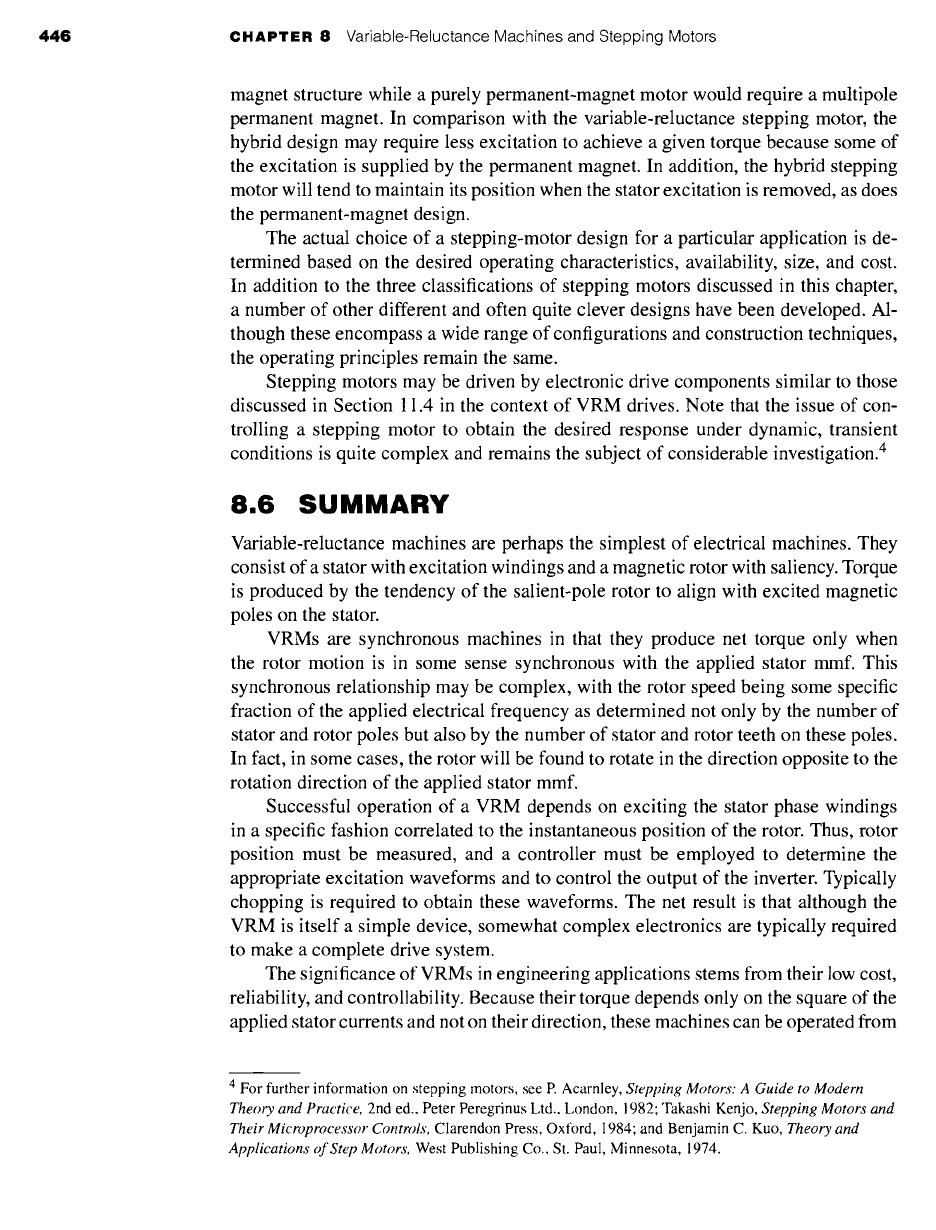
446 CHAPTER
8 Variable-Reluctance Machines and Stepping Motors
magnet structure while a purely permanent-magnet motor would require a multipole
permanent magnet. In comparison with the variable-reluctance stepping motor, the
hybrid design may require less excitation to achieve a given torque because some of
the excitation is supplied by the permanent magnet. In addition, the hybrid stepping
motor will tend to maintain its position when the stator excitation is removed, as does
the permanent-magnet design.
The actual choice of a stepping-motor design for a particular application is de-
termined based on the desired operating characteristics, availability, size, and cost.
In addition to the three classifications of stepping motors discussed in this chapter,
a number of other different and often quite clever designs have been developed. Al-
though these encompass a wide range of configurations and construction techniques,
the operating principles remain the same.
Stepping motors may be driven by electronic drive components similar to those
discussed in Section 11.4 in the context of VRM drives. Note that the issue of con-
trolling a stepping motor to obtain the desired response under dynamic, transient
conditions is quite complex and remains the subject of considerable investigation. 4
8.6 SUMMARY
Variable-reluctance machines are perhaps the simplest of electrical machines. They
consist of a stator with excitation windings and a magnetic rotor with saliency. Torque
is produced by the tendency of the salient-pole rotor to align with excited magnetic
poles on the stator.
VRMs are synchronous machines in that they produce net torque only when
the rotor motion is in some sense synchronous with the applied stator mmf. This
synchronous relationship may be complex, with the rotor speed being some specific
fraction of the applied electrical frequency as determined not only by the number of
stator and rotor poles but also by the number of stator and rotor teeth on these poles.
In fact, in some cases, the rotor will be found to rotate in the direction opposite to the
rotation direction of the applied stator mmf.
Successful operation of a VRM depends on exciting the stator phase windings
in a specific fashion correlated to the instantaneous position of the rotor. Thus, rotor
position must be measured, and a controller must be employed to determine the
appropriate excitation waveforms and to control the output of the inverter. Typically
chopping is required to obtain these waveforms. The net result is that although the
VRM is itself a simple device, somewhat complex electronics are typically required
to make a complete drive system.
The significance of VRMs in engineering applications stems from their low cost,
reliability, and controllability. Because their torque depends only on the square of the
applied stator currents and not on their direction, these machines can be operated from
4
For further information on stepping motors, see P. Acarnley,
Stepping Motors: A Guide to Modern
Theory and Practice,
2nd ed., Peter Peregrinus Ltd., London, 1982; Takashi Kenjo,
Stepping Motors and
Their Microprocessor Controls,
Clarendon Press, Oxford, 1984; and Benjamin C. Kuo,
Theory and
Applications of Step Motors',
West Publishing Co., St. Paul, Minnesota, 1974.
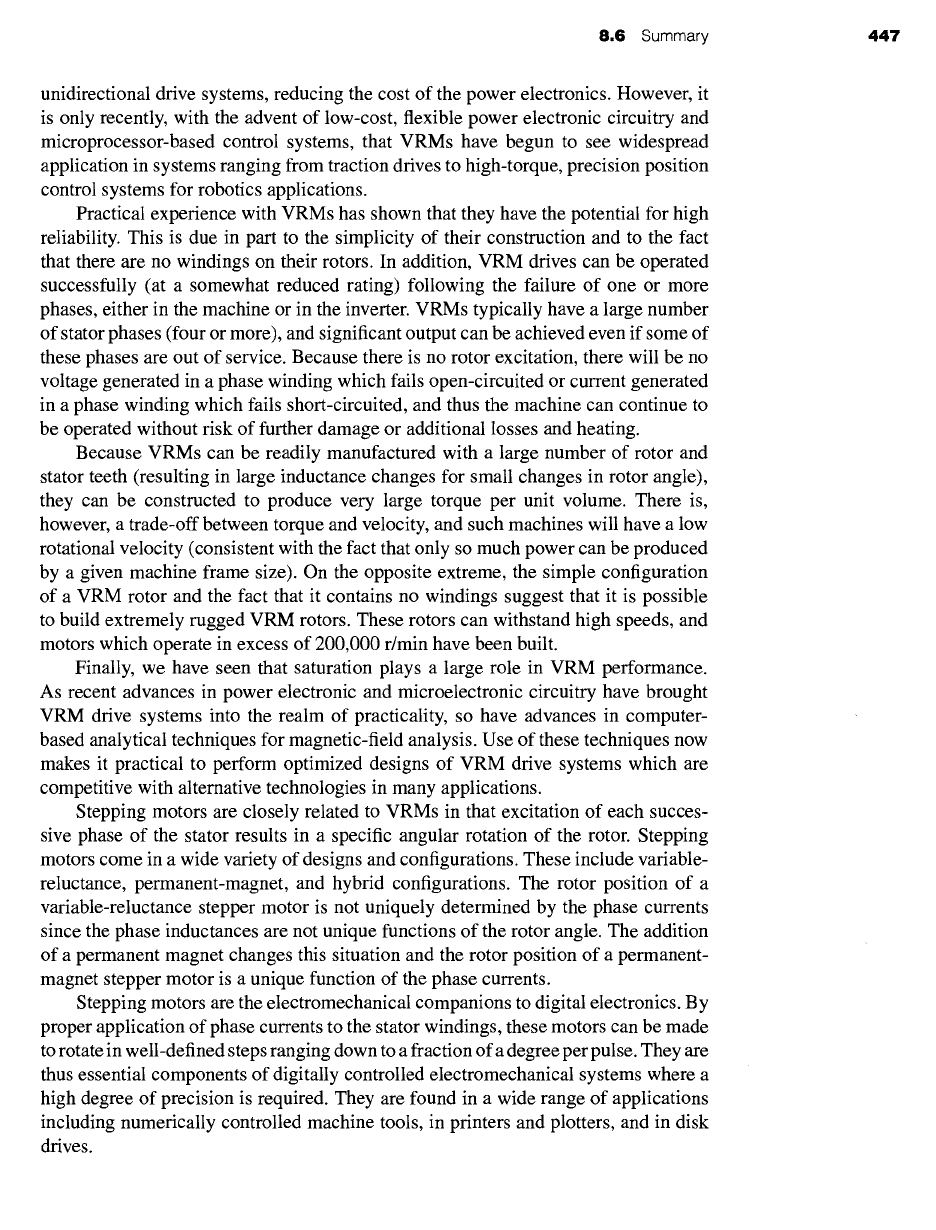
8.6 Summary 447
unidirectional drive systems, reducing the cost of the power electronics. However, it
is only recently, with the advent of low-cost, flexible power electronic circuitry and
microprocessor-based control systems, that VRMs have begun to see widespread
application in systems ranging from traction drives to high-torque, precision position
control systems for robotics applications.
Practical experience with VRMs has shown that they have the potential for high
reliability. This is due in part to the simplicity of their construction and to the fact
that there are no windings on their rotors. In addition, VRM drives can be operated
successfully (at a somewhat reduced rating) following the failure of one or more
phases, either in the machine or in the inverter. VRMs typically have a large number
of stator phases (four or more), and significant output can be achieved even if some of
these phases are out of service. Because there is no rotor excitation, there will be no
voltage generated in a phase winding which fails open-circuited or current generated
in a phase winding which fails short-circuited, and thus the machine can continue to
be operated without risk of further damage or additional losses and heating.
Because VRMs can be readily manufactured with a large number of rotor and
stator teeth (resulting in large inductance changes for small changes in rotor angle),
they can be constructed to produce very large torque per unit volume. There is,
however, a trade-off between torque and velocity, and such machines will have a low
rotational velocity (consistent with the fact that only so much power can be produced
by a given machine frame size). On the opposite extreme, the simple configuration
of a VRM rotor and the fact that it contains no windings suggest that it is possible
to build extremely rugged VRM rotors. These rotors can withstand high speeds, and
motors which operate in excess of 200,000 r/min have been built.
Finally, we have seen that saturation plays a large role in VRM performance.
As recent advances in power electronic and microelectronic circuitry have brought
VRM drive systems into the realm of practicality, so have advances in computer-
based analytical techniques for magnetic-field analysis. Use of these techniques now
makes it practical to perform optimized designs of VRM drive systems which are
competitive with alternative technologies in many applications.
Stepping motors are closely related to VRMs in that excitation of each succes-
sive phase of the stator results in a specific angular rotation of the rotor. Stepping
motors come in a wide variety of designs and configurations. These include variable-
reluctance, permanent-magnet, and hybrid configurations. The rotor position of a
variable-reluctance stepper motor is not uniquely determined by the phase currents
since the phase inductances are not unique functions of the rotor angle. The addition
of a permanent magnet changes this situation and the rotor position of a permanent-
magnet stepper motor is a unique function of the phase currents.
Stepping motors are the electromechanical companions to digital electronics. By
proper application of phase currents to the stator windings, these motors can be made
to rotate in well-defined steps ranging down to a fraction of a degree per pulse. They are
thus essential components of digitally controlled electromechanical systems where a
high degree of precision is required. They are found in a wide range of applications
including numerically controlled machine tools, in printers and plotters, and in disk
drives.
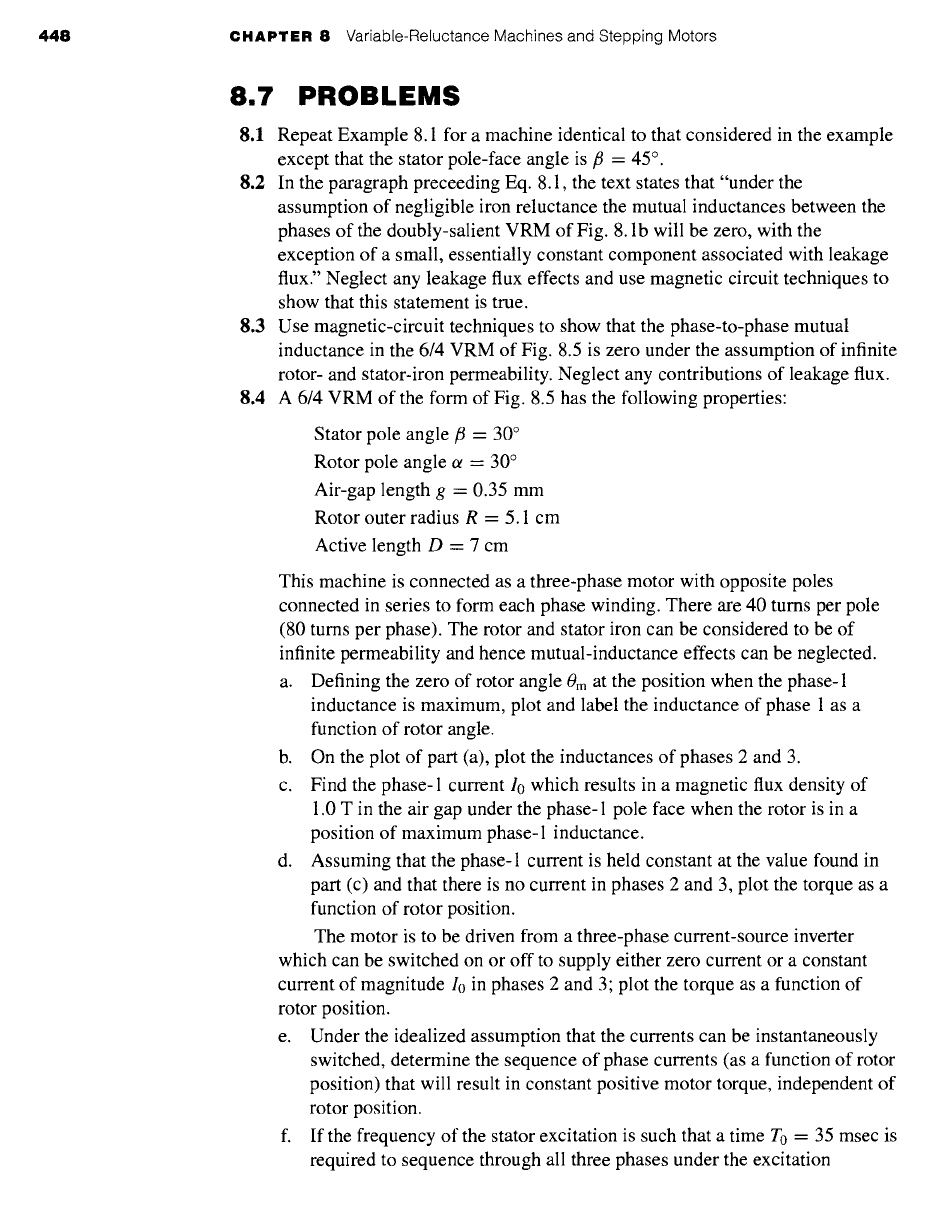
448 CHAPTER 8 Variable-Reluctance Machines and Stepping Motors
8.7 PROBLEMS
8.1 Repeat Example 8.1 for a machine identical to that considered in the example
except that the stator pole-face angle is ,8 = 45 °.
8.2 In the paragraph preceeding Eq. 8.1, the text states that "under the
assumption of negligible iron reluctance the mutual inductances between the
phases of the doubly-salient VRM of Fig. 8. lb will be zero, with the
exception of a small, essentially constant component associated with leakage
flux." Neglect any leakage flux effects and use magnetic circuit techniques to
show that this statement is true.
8.3 Use magnetic-circuit techniques to show that the phase-to-phase mutual
inductance in the 6/4 VRM of Fig. 8.5 is zero under the assumption of infinite
rotor- and stator-iron permeability. Neglect any contributions of leakage flux.
8.4 A 6/4 VRM of the form of Fig. 8.5 has the following properties:
Stator pole angle/~ = 30 °
Rotor pole angle ot -- 30 °
Air-gap length g = 0.35 mm
Rotor outer radius R = 5.1 cm
Active length D = 7 cm
This machine is connected as a three-phase motor with opposite poles
connected in series to form each phase winding. There are 40 turns per pole
(80 turns per phase). The rotor and stator iron can be considered to be of
infinite permeability and hence mutual-inductance effects can be neglected.
a. Defining the zero of rotor angle 0m at the position when the phase-1
inductance is maximum, plot and label the inductance of phase 1 as a
function of rotor angle.
b. On the plot of part (a), plot the inductances of phases 2 and 3.
c. Find the phase-1 current I0 which results in a magnetic flux density of
1.0 T in the air gap under the phase-1 pole face when the rotor is in a
position of maximum phase-1 inductance.
d. Assuming that the phase-1 current is held constant at the value found in
part (c) and that there is no current in phases 2 and 3, plot the torque as a
function of rotor position.
The motor is to be driven from a three-phase current-source inverter
which can be switched on or off to supply either zero current or a constant
current of magnitude I0 in phases 2 and 3; plot the torque as a function of
rotor position.
e. Under the idealized assumption that the currents can be instantaneously
switched, determine the sequence of phase currents (as a function of rotor
position) that will result in constant positive motor torque, independent of
rotor position.
f. If the frequency of the stator excitation is such that a time To = 35 msec is
required to sequence through all three phases under the excitation
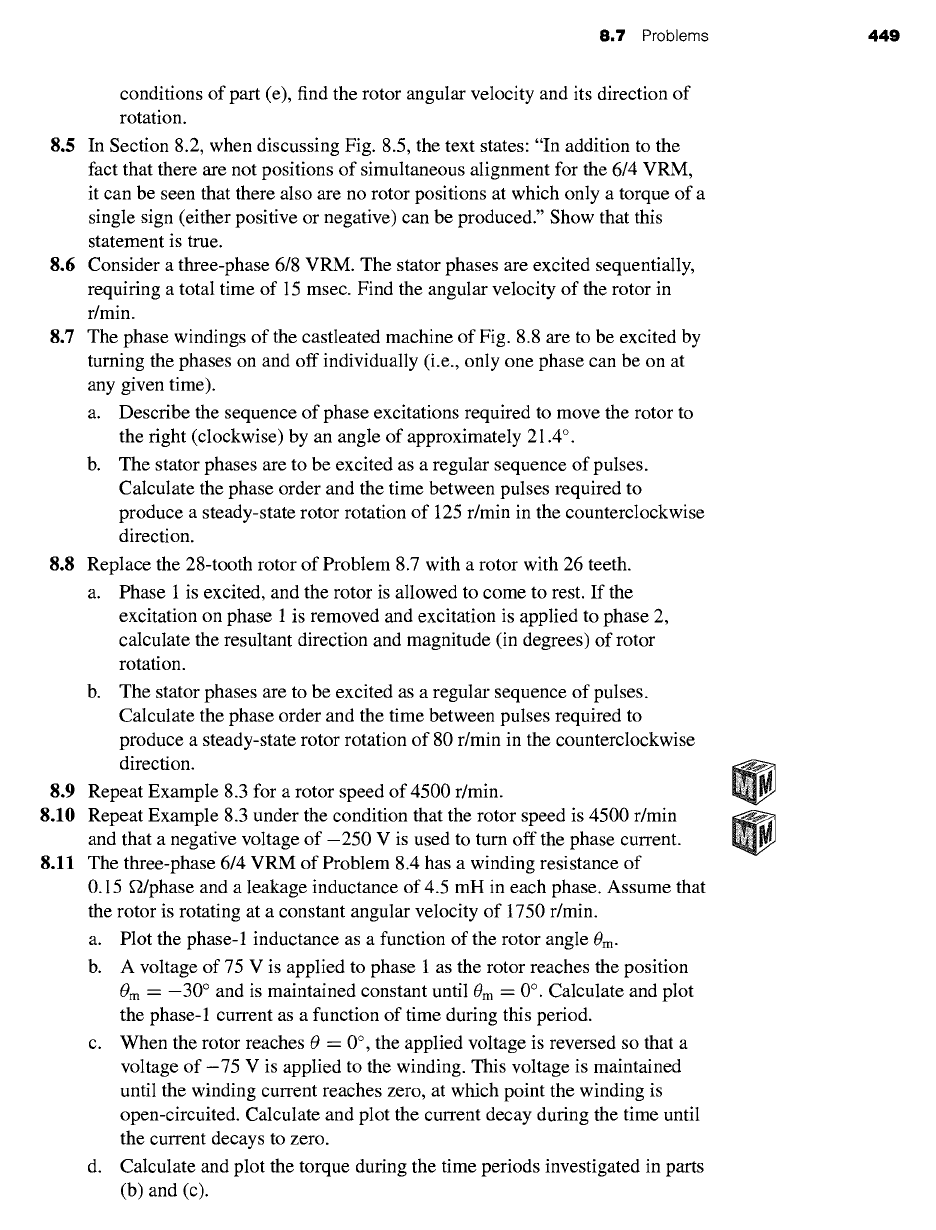
8.7 Problems 449
conditions of part (e), find the rotor angular velocity and its direction of
rotation.
8.5 In Section 8.2, when discussing Fig. 8.5, the text states: "In addition to the
fact that there are not positions of simultaneous alignment for the 6/4 VRM,
it can be seen that there also are no rotor positions at which only a torque of a
single sign (either positive or negative) can be produced." Show that this
statement is true.
8.6 Consider a three-phase 6/8 VRM. The stator phases are excited sequentially,
requiting a total time of 15 msec. Find the angular velocity of the rotor in
r/min.
8.7 The phase windings of the castleated machine of Fig. 8.8 are to be excited by
turning the phases on and off individually (i.e., only one phase can be on at
any given time).
a. Describe the sequence of phase excitations required to move the rotor to
the fight (clockwise) by an angle of approximately 21.4 °.
b. The stator phases are to be excited as a regular sequence of pulses.
Calculate the phase order and the time between pulses required to
produce a steady-state rotor rotation of 125 r/min in the counterclockwise
direction.
8.8 Replace the 28-tooth rotor of Problem 8.7 with a rotor with 26 teeth.
a. Phase 1 is excited, and the rotor is allowed to come to rest. If the
excitation on phase 1 is removed and excitation is applied to phase 2,
calculate the resultant direction and magnitude (in degrees) of rotor
rotation.
b. The stator phases are to be excited as a regular sequence of pulses.
Calculate the phase order and the time between pulses required to
produce a steady-state rotor rotation of 80 r/min in the counterclockwise
direction.
8.9 Repeat Example 8.3 for a rotor speed of 4500 r/min.
8.10 Repeat Example 8.3 under the condition that the rotor speed is 4500 r/min
and that a negative voltage of -250 V is used to turn off the phase current.
8.11 The three-phase 6/4 VRM of Problem 8.4 has a winding resistance of
0.15 fl/phase and a leakage inductance of 4.5 mH in each phase. Assume that
the rotor is rotating at a constant angular velocity of 1750 ffmin.
a. Plot the phase-1 inductance as a function of the rotor angle 0m.
b. A voltage of 75 V is applied to phase 1 as the rotor reaches the position
0m =
-30 ° and is maintained constant until
0m =
0 °. Calculate and plot
the phase-1 current as a function of time during this period.
c. When the rotor reaches 0 = 0 °, the applied voltage is reversed so that a
voltage of-75 V is applied to the winding. This voltage is maintained
until the winding current reaches zero, at which point the winding is
open-circuited. Calculate and plot the current decay during the time until
the current decays to zero.
d. Calculate and plot the torque during the time periods investigated in parts
(b) and (c).
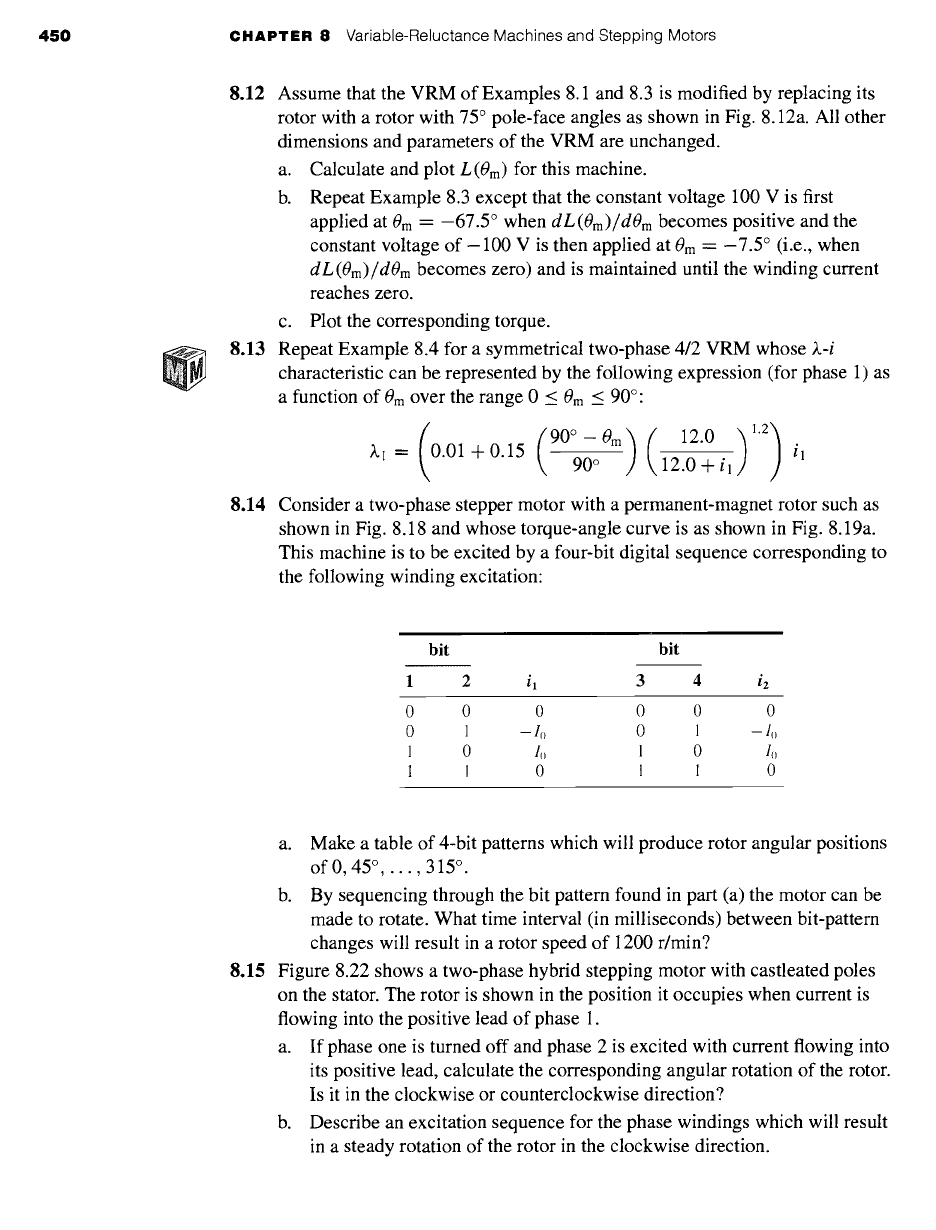
450
CHAPTER 8 Variable-Reluctance Machines and Stepping Motors
$
8.12 Assume that the VRM of Examples 8.1 and 8.3 is modified by replacing its
rotor with a rotor with 75 ° pole-face angles as shown in Fig. 8.12a. All other
dimensions and parameters of the VRM are unchanged.
a. Calculate and plot L(0m) for this machine.
b. Repeat Example 8.3 except that the constant voltage 100 V is first
applied at 0m = -67.5 ° when
dL(Om)/dOm
becomes positive and the
constant voltage of- 100 V is then applied at 0m = -7.5 ° (i.e., when
d L(Om)/dOm
becomes zero) and is maintained until the winding current
reaches zero.
c. Plot the corresponding torque.
8.13 Repeat Example 8.4 for a symmetrical two-phase 4/2 VRM whose ~.-i
characteristic can be represented by the following expression (for phase 1) as
a function of 0m over the range 0 < 0m _< 90°:
).l __ (0.01_~._ 0.15 (90°--Oml I 12.0 ) 1"2 )
il
90 ° 12.0 -+-
il
8.14 Consider a two-phase stepper motor with a permanent-magnet rotor such as
shown in Fig. 8.18 and whose torque-angle curve is as shown in Fig. 8.19a.
This machine is to be excited by a four-bit digital sequence corresponding to
the following winding excitation:
it t lllt
bit
bit
1 2
il
3 4 i2
0 0 0 0 0 0
0 1 - I~ 0 1 - I<1
1 0 Ill 1 0 1~1
1 1 0 t 1 0
a. Make a table of 4-bit patterns which will produce rotor angular positions
of 0,45°,..., 315 ° .
b. By sequencing through the bit pattern found in part (a) the motor can be
made to rotate. What time interval (in milliseconds) between bit-pattern
changes will result in a rotor speed of 1200 r/min?
8.15 Figure 8.22 shows a two-phase hybrid stepping motor with castleated poles
on the stator. The rotor is shown in the position it occupies when current is
flowing into the positive lead of phase 1.
a. If phase one is turned off and phase 2 is excited with current flowing into
its positive lead, calculate the corresponding angular rotation of the rotor.
Is it in the clockwise or counterclockwise direction?
b. Describe an excitation sequence for the phase windings which will result
in a steady rotation of the rotor in the clockwise direction.
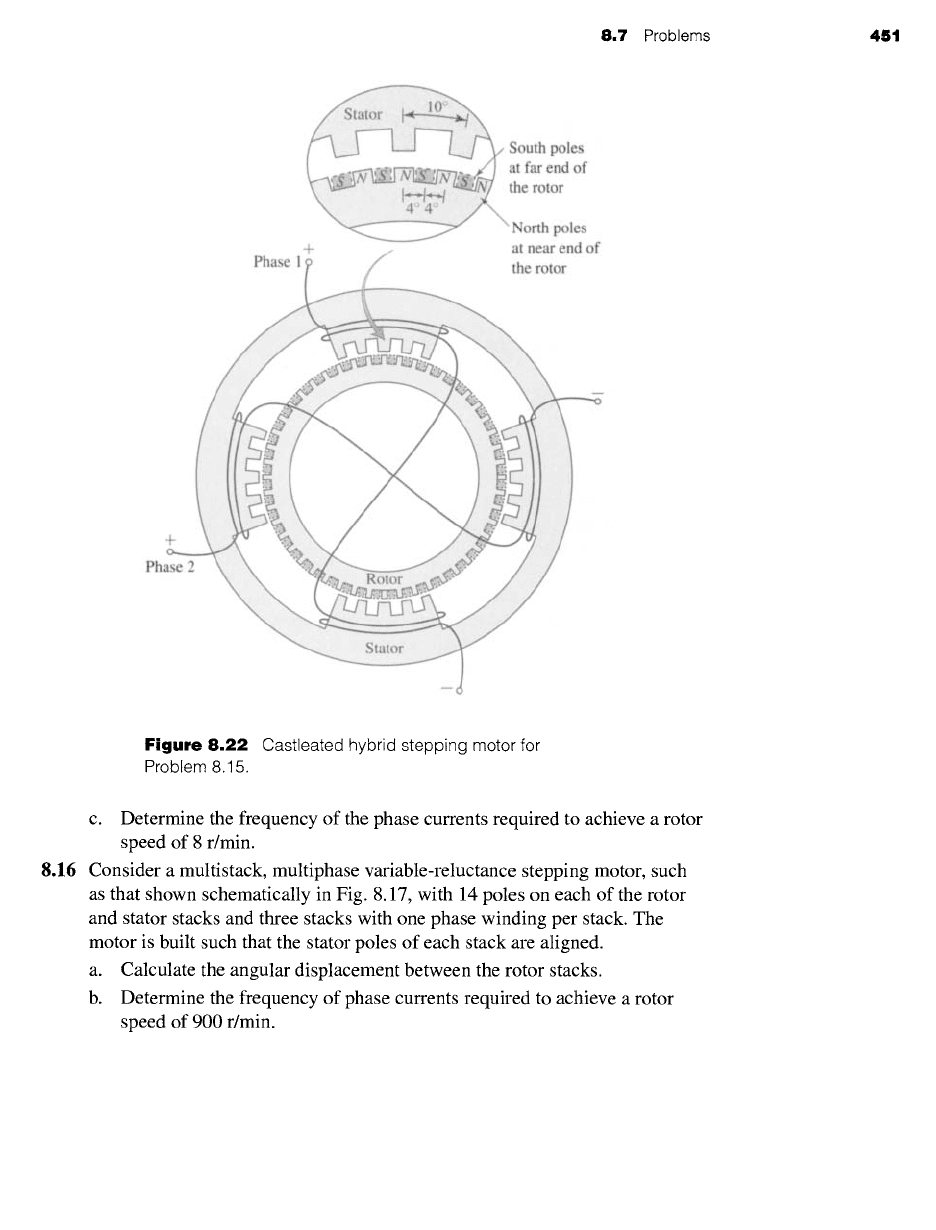
8.7 Problems 451
Phase 1
poles
~nd of
:or
poles
at near end of
the rotor
+
o,..,.._
Phase 2
Figure 8.22
Castleated hybrid stepping motor for
Problem 8.15.
c. Determine the frequency of the phase currents required to achieve a rotor
speed of 8 r/min.
8.16 Consider a multistack, multiphase variable-reluctance stepping motor, such
as that shown schematically in Fig. 8.17, with 14 poles on each of the rotor
and stator stacks and three stacks with one phase winding per stack. The
motor is built such that the stator poles of each stack are aligned.
a. Calculate the angular displacement between the rotor stacks.
b. Determine the frequency of phase currents required to achieve a rotor
speed of 900 r/min.
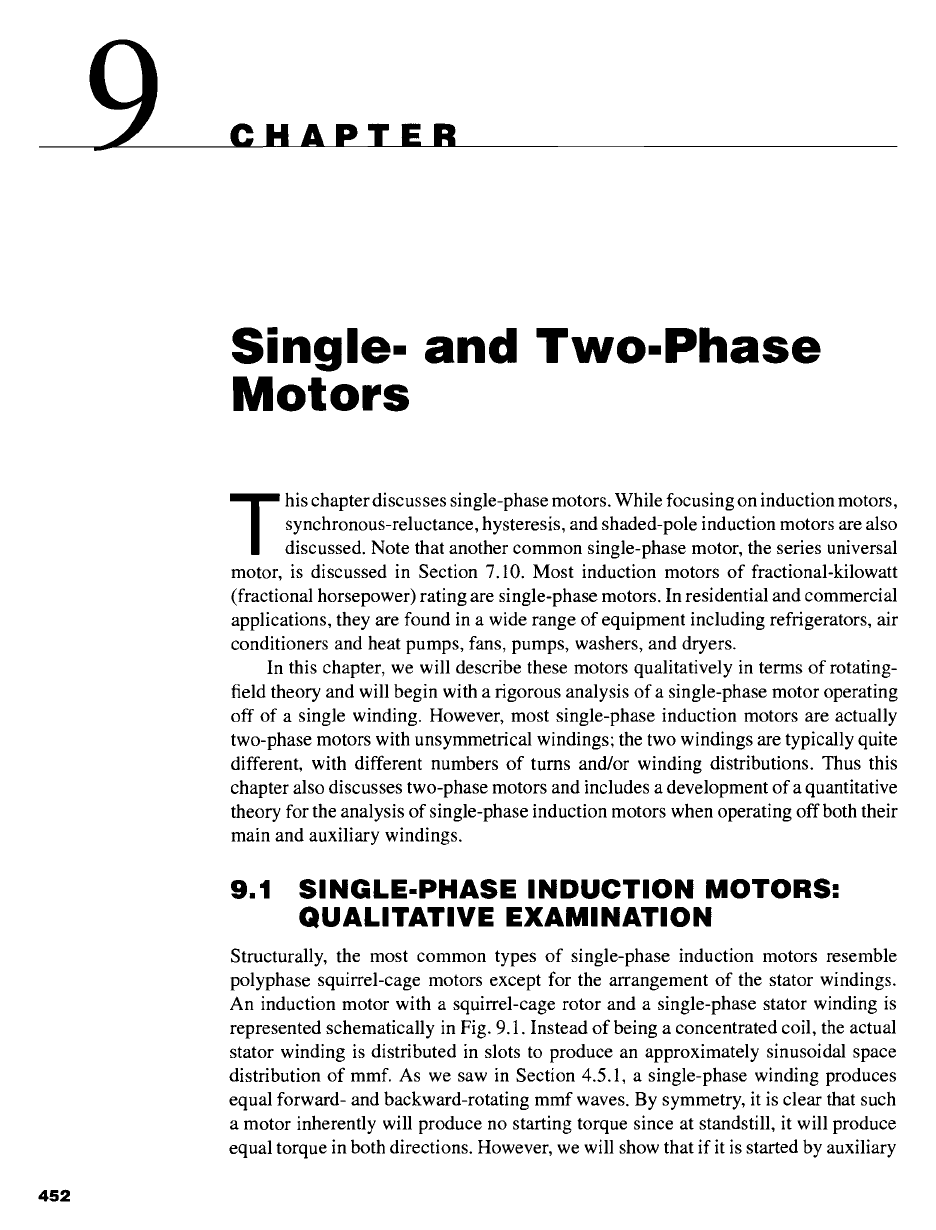
CHAPTER
Single. and Two.Phase
Motors
T
his chapter discusses single-phase motors. While focusing on induction motors,
synchronous-reluctance, hysteresis, and shaded-pole induction motors are also
discussed. Note that another common single-phase motor, the series universal
motor, is discussed in Section 7.10. Most induction motors of fractional-kilowatt
(fractional horsepower) rating are single-phase motors. In residential and commercial
applications, they are found in a wide range of equipment including refrigerators, air
conditioners and heat pumps, fans, pumps, washers, and dryers.
In this chapter, we will describe these motors qualitatively in terms of rotating-
field theory and will begin with a rigorous analysis of a single-phase motor operating
off of a single winding. However, most single-phase induction motors are actually
two-phase motors with unsymmetrical windings; the two windings are typically quite
different, with different numbers of turns and/or winding distributions. Thus this
chapter also discusses two-phase motors and includes a development of a quantitative
theory for the analysis of single-phase induction motors when operating off both their
main and auxiliary windings.
9.1
SINGLE-PHASE INDUCTION MOTORS:
QUALITATIVE EXAMINATION
Structurally, the most common types of single-phase induction motors resemble
polyphase squirrel-cage motors except for the arrangement of the stator windings.
An induction motor with a squirrel-cage rotor and a single-phase stator winding is
represented schematically in Fig. 9.1. Instead of being a concentrated coil, the actual
stator winding is distributed in slots to produce an approximately sinusoidal space
distribution of mmf. As we saw in Section 4.5.1, a single-phase winding produces
equal forward- and backward-rotating mmf waves. By symmetry, it is clear that such
a motor inherently will produce no starting torque since at standstill, it will produce
equal torque in both directions. However, we will show that if it is started by auxiliary
452
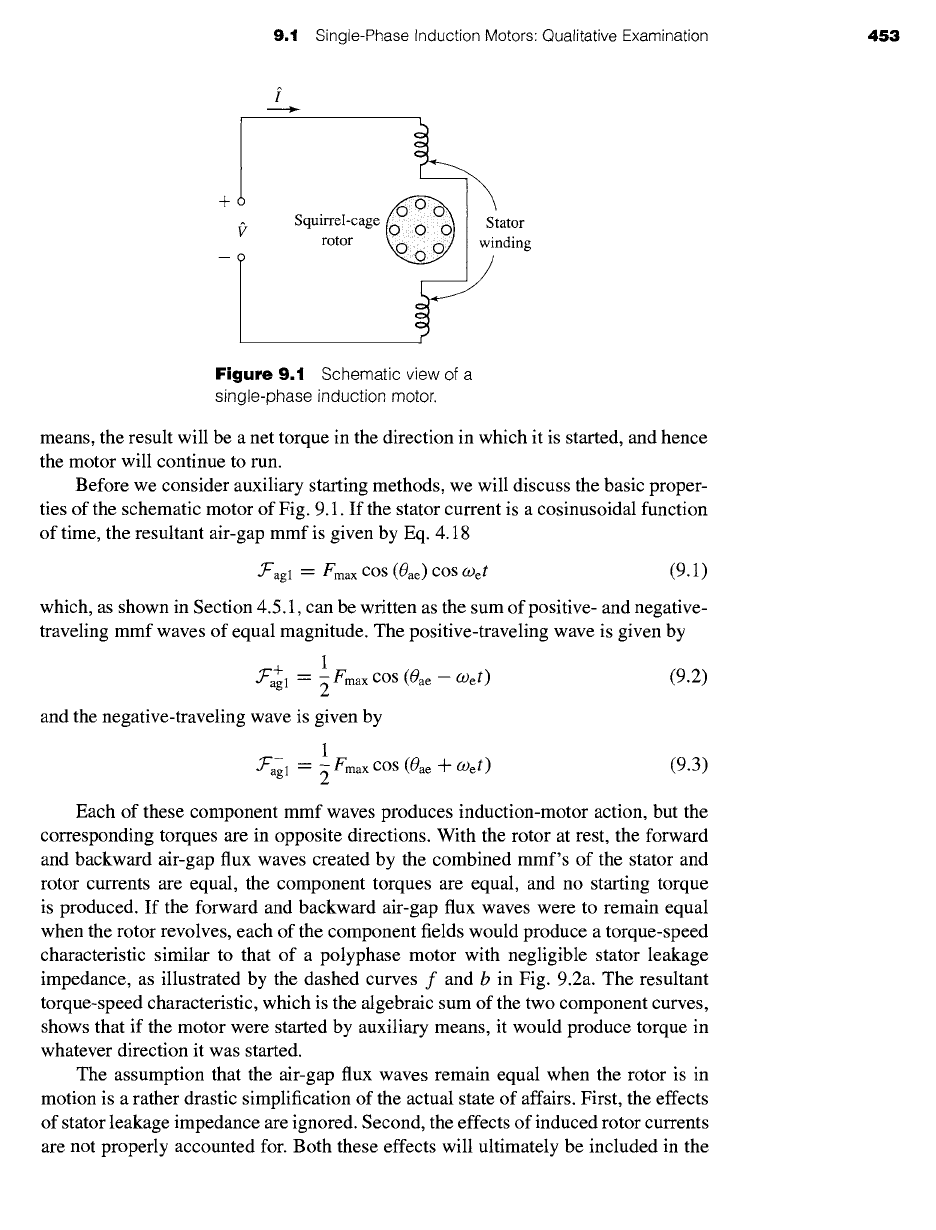
9,1 Single-Phase Induction Motors: Qualitative Examination 458
i
+1
f. Squirrel-cage [ Stator
rotor ] winding
Figure
9.1 Schematic view of a
single-phase induction motor.
means, the result will be a net torque in the direction in which it is started, and hence
the motor will continue to run.
Before we consider auxiliary starting methods, we will discuss the basic proper-
ties of the schematic motor of Fig. 9.1. If the stator current is a cosinusoidal function
of time, the resultant air-gap mmf is given by Eq. 4.18
• f'agl = Fmax cos (0ae) cos
COet (9.1)
which, as shown in Section 4.5.1, can be written as the sum of positive- and negative-
traveling mmf waves of equal magnitude. The positive-traveling wave is given by
1
f'a+l = ~ Frnax cos (0,e -- Wet) (9.2)
and the negative-traveling wave is given by
1
• f'agl
-- 2
Fmax
COS (0ae -+-
C_Oet) (9.3)
Each of these component mmf waves produces induction-motor action, but the
corresponding torques are in opposite directions. With the rotor at rest, the forward
and backward air-gap flux waves created by the combined mmf's of the stator and
rotor currents are equal, the component torques are equal, and no starting torque
is produced. If the forward and backward air-gap flux waves were to remain equal
when the rotor revolves, each of the component fields would produce a torque-speed
characteristic similar to that of a polyphase motor with negligible stator leakage
impedance, as illustrated by the dashed curves f and b in Fig. 9.2a. The resultant
torque-speed characteristic, which is the algebraic sum of the two component curves,
shows that if the motor were started by auxiliary means, it would produce torque in
whatever direction it was started.
The assumption that the air-gap flux waves remain equal when the rotor is in
motion is a rather drastic simplification of the actual state of affairs. First, the effects
of stator leakage impedance are ignored. Second, the effects of induced rotor currents
are not properly accounted for. Both these effects will ultimately be included in the
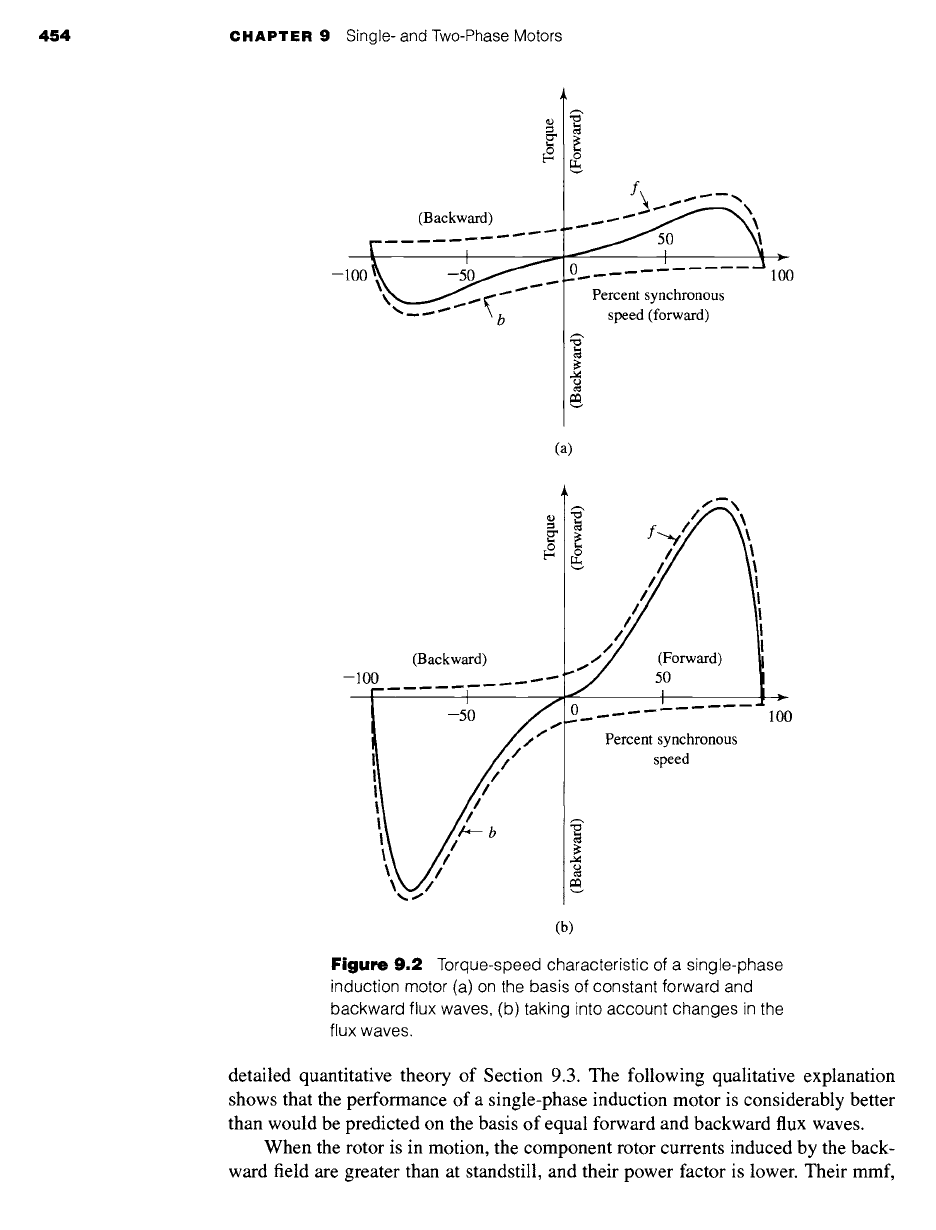
454 CHAPTER 9
Single- and Two-Phase Motors
(Backward) -- ~ ~ ~ ~\
-100 .......... ,00
"%'~._...,.,,,,'~ ~ ~. ~ "- [ Percent synchronous
%_~r "\ b [ speed (forward)
(a)
--100
¢ o
|
/ I
(Backward) (Forward)
..i/
50
..... 7/1_~
1
Jr r
--50 /j~..~ ~
.........
100
Percent synchronous
speed
',,V,,"
(b)
Figure 9.2
Torque-speed characteristic of a single-phase
induction motor (a) on the basis of constant forward and
backward flux waves, (b) taking into account changes in the
flux waves.
detailed quantitative theory of Section 9.3. The following qualitative explanation
shows that the performance of a single-phase induction motor is considerably better
than would be predicted on the basis of equal forward and backward flux waves.
When the rotor is in motion, the component rotor currents induced by the back-
ward field are greater than at standstill, and their power factor is lower. Their mmf,

9.2 Starting and Running Performance of Single-Phase Induction and Synchronous Motors 455
which opposes that of the stator current, results in a reduction of the backward
flux wave. Conversely, the magnetic effect of the component currents induced by
the forward field is less than at standstill because the rotor currents are less and their
power factor is higher. As speed increases, therefore, the forward flux wave increases
while the backward flux wave decreases. The sum of these flux waves must remain
roughly constant since it must induce the stator counter emf, which is approximately
constant if the stator leakage-impedance voltage drop is small.
Hence, with the rotor in motion, the torque of the forward field is greater and
that of the backward field less than in Fig. 9.2a, the true situation being about that
shown in Fig. 9.2b. In the normal running region at a few percent slip, the forward
field is several times greater than the backward field, and the flux wave does not
differ greatly from the constant-amplitude revolving field in the air gap of a bal-
anced polyphase motor. In the normal running region, therefore, the torque-speed
characteristic of a single-phase motor is not too greatly inferior to that of a polyphase
motor having the same rotor and operating with the same maximum air-gap flux
density.
In addition to the torques shown in Fig. 9.2, double-stator-frequency torque
pulsations are produced by the interactions of the oppositely rotating flux and mmf
waves which rotate past each other at twice synchronous speed. These interactions
produce no average torque, but they tend to make the motor noisier than a polyphase
motor. Such torque pulsations are unavoidable in a single-phase motor because of the
pulsations in instantaneous power input inherent in a single-phase circuit. The effects
of the pulsating torque can be minimized by using an elastic mounting for the motor.
The torque referred to on the torque-speed curves of a single-phase motor is the time
average of the instantaneous torque.
9.2 STARTING AND RUNNING
PERFORMANCE OF SINGLE-PHASE
INDUCTION AND SYNCHRONOUS
MOTORS
Single-phase induction motors are classified in accordance with their starting methods
and are usually referred to by names descriptive of these methods. Selection of the
appropriate motor is based on the starting- and running-torque requirements of the
load, the duty cycle of the load, and the limitations on starting and running current
from the supply line for the motor. The cost of single-phase motors increases with
their rating and with their performance characteristics such as starting-torque-to-
current ratio. Typically, in order to minimize cost, an application engineer will select
the motor with the lowest rating and performance that can meet the specifications
of the application. Where a large number of motors are to be used for a specific
purpose, a special motor may be designed in order to ensure the least cost. In the
fractional-kilowatt motor business, small differences in cost are important.
Starting methods and the resulting torque-speed characteristics are considered
qualitatively in this section. A quantitative theory for analyzing these motors is de-
veloped in Section 9.4.2.
